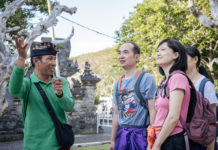When travelling to Vietnam, short-term travellers tend to get stuck in cities like Ho Chi Minh (Saigon) or Hanoi in the north. At most, they end up a little further out in the famous highlands of Sa Pa or the karst cliffs of Ha Long Bay. But if you’re in the central area, here’s our guide to Da Nang, Hoi An, and Hue just for you!
On her fourth trip to the country, TripGuru resident blogger Yeni R of Morena Travels finally makes it to Central Vietnam, an overlooked UNESCO hotspot growing at breakneck speed…
While the rest of Southeast Asia suffers through monsoon rains from June to September, Da Nang and its surrounds appeal to the summer traveller as a singularly dry spot in the midst of seemingly torrential downpour.
If you’re looking to avoid the rains, like us, Da Nang is the one place in Southeast Asia to go from April to September, aside from Bali of course. However, having been to Bali just the month before (read: extortionate flight prices during high season!), we decided to follow a friend’s advice to head to Da Nang, the Unesco World Heritage Hoi An, and their surrounds.
Editor’s Note: February to May has also been said to be the best time to visit Da Nang

Turns out, we were well advised! Yes, it was hot as hell, but what’s new in Southeast Asia?! At least we could motorbike from place to place to our heart’s content without getting caught in the floods that happened to be tormenting Hanoi that July. Just make sure to take lots of water with you, and maybe pick up a fan that will surprise you with its powers to stop one from overheating.
Visa issues
Before I proceed with my Da Nang Top 10, let me give a word of warning! Check your visa status with your local Vietnam Embassy. HK Express nearly wrongfully off-boarded my travel companion for not having an e-visa to Vietnam, as he took it for granted that he could get a visa on arrival upon landing at the airport.
There are a lot of scammers on the web pretending to be official government sites, so make sure to do your research properly and get that visa in advance!

Health issues
Be careful of what you eat in Vietnam. I was literally hospitalized half the time I was there due to acute gastroenteritis. Try to eat clean and wash your hands all the time! When I posted about it on IG, quite a few friends replied saying the same thing happened to them in Vietnam. And to think, this happened to me despite avoiding eating street food!
Getting around: Motorbike / Scooter!
If you’re the adventurous kind, I would 100% recommend getting around by motorbike. It’s not only the most economical way, but also potentially the fastest and funnest. People told us it would take 2 hours to get from Da Nang to My Son; it only took us a little over an hour.
They also said Hoi An to Da Nang would take an hour; we did 45 minutes, max! Of course this all depends on weather conditions, traffic and driving skills. There are pros and cons for each mode of transportation, but this was what suited us best.
Motorbike Rental from our beachfront hotel cost around USD7 per day without fuel.

Top 10 In and Around Da Nang, Hội An & Huế
1. Da Nang: Vietnam’s Miami?
Who doesn’t love a beach city? Blessed with seemingly endless stretches of white sand, Da Nang is the country’s third fastest-developing city midway between Hanoi and Ho Chi Minh. Clearly tonnes of (Chinese?) money is being pumped into its infrastructure drive, as the last decade has transformed the place from a backwater to a well-organized metropolis with developed waterfronts, dual carriageways and “dragon” bridges.
If you’re the resort type, make a beeline for Non Nuoc Beach – a powdery stretch of sand on the outskirts, renowned for its history as an R&R destination for American troops during the Vietnam War. Today, it’s home to grand resorts, and yes, surfing when the swell is in town!

2. My Khe Beach: Our base
We chose to stay at My Khe beach, Da Nang, making the most of our holiday on the beachfront, and strategically located in the middle of UNESCO cities Hoi An, Hue and My Son. If you like to wake up to views of the sea, this is your place.
We stayed at the wonderful Belle Maison Parosand Da Nang Hotel, comfortable enough but not too comfortable that we would be tempted to stay in rather than exploring the great cultural and natural sights around us! Breakfast was a delightful surprise, service sincere and par excellence.
3. Son Tra Mountains, Da Nang
For great views of the city, drive 7 kilometers north towards the Linh Ung Buddhist Temple on the Son Tra Peninsula. Approaching this from afar, you can’t miss the giant 67-meter tall statue of “Quan The Am” – the “Goddess of Mercy” (although some call her the “Lady Buddha”, if that even exists?!).
The Son Tra Peninsula is a great area of Da Nang to explore, although not as popular as its UNESCO recognized neighbors. There you can also find the Man Thai Fishing Village, dramatic cliffs, a Giant Banyan Tree, the Monkey Passage (monkeys and beautiful views!), Ban Co Peak (famous for its statue of Confucius), Spanish and French War Graves, Black Stone Beach and Tien Sa Harbour.
4. Hoi An: Ancient Town

Hoi An, for some, would be the one main reason people would come to this part of Vietnam. The Old Town, whose history goes back 2,000 years, was granted UNESCO World Heritage Site status for its heritage halls, bridges, houses and pagodas. I would recommend coming here in the late afternoon, and walking around in the evening when the lanterns light up. Sans the sometimes-overwhelming crowds, it can be quite a magical experience.
We had dinner at the famous Morning Glory restaurant, where we had the local favourites Cao lầu, a regional Vietnamese dish made with noodles, pork, and local greens, found only in this town, specifically! There are also a lot of artisan / craft shops around, aside from your regular Vietnamese market ware.
Check out some of the most Instagrammable spots in Hoi An (because we know you want to), and this Essential Food Tour celebrating this foodie capital’s exquisite flavors!
5. Hai Van Pass: The high road to Hue

The iconic Hải Vân (“Sea Clouds”) Pass is a 21-kilometer stretch of mountain road between Da Nang and Hue, former seat of Vietnam’s emperors. If you’re going to Hue from Da Nang (and so you should!), Hai Van Pass is a must. In fact, for avid bikers, Hai Van Pass is the main point of coming here, especially after BBC TV’s Top Gear featured it as “one of the best coast roads in the world.”
The two best ways to go are by train or motorbike (cars usually skip the best yet most challenging part and go through the tunnel). The train is a comfortable 3-hour journey offering spectacular views along the way. By motorbike, you will climb an elevation of almost 500m navigating “hairpin bends and winding steep roads, all with a constant spectacular view of the ocean, coastline, beaches, and back over the roads and mountain itself.”
6. The Imperial City of Huế

During its heyday in the 19th century, Hue was Vietnam’s capital for nearly 150 years. The Imperial Citadel (Đại Nội) is the major sight to see here, a massive complex of temples, palaces, the “Forbidden Purple City” and the tragic Hue Jungle Crevice, where the Viet Cong pushed thousands to their deaths. You could easily spend half a day here before moving on to the Tombs of the Emperors, along the Perfume River. There you can go for a lunch cruise and then head to the tombs from the wharf.
Unless you have all day and unlimited stamina, you will need transportation to get around the Nguyễn Dynasty tombs, which can have several kilometers worth of distance separating them. Some opt for the rustic bicycle – you choose your ride! Realistically, you can hit the three major tombs in half a day: the tranquil and naturally wooded Tomb of Minh Mang, the lakeside Tomb of Tu Duc and well preserved Tomb of Khai Dinh.
5. My Son: Ruins of a Lost Civilization


If Hue reminds you of Beijing’s Forbidden City, Mỹ Sơn might remind you of the sprawling jungle temples of Cambodia’s Angkor Wat. That being said, however, don’t expect the same grandiosity here, as My Son was majorly damaged during the wars, and worn down by over a thousand years of use (and disuse). Nevertheless, it’s worth exploring the sacred grounds of the Champa kingdom, a lost civilization that once flourished here from the 4th to 14th century AD.
This UNESCO World Heritage Site is regarded as one of the foremost Hindu temple complexes in Southeast Asia, sometimes compared to Borobudur of Java in Indonesia, Bagan of Myanmar and Ayutthaya of Thailand.
8. Marble Mountains: More than meets the eye

And while we’re making comparisons, why not liken Da Nang’s Marble Mountains to Guilin in Southern China? This cluster of five marble and limestone hills (“Five Elements Mountains” in the local tongue) were named after the same: Kim (metal), Thuy (water), Moc (wood), Hoa (fire) and Tho (earth). All feature cave entrances and multiple tunnels, but we visited the biggest of them all: Thuy Son (water).
You could easily spend hours in Thuy Son alone, which features six caves / underground caverns, four pagodas up top, three towers and more nooks and crannies to explore. We were definitely disturbed by the images depicting “nine levels of Buddhist hell” at Am Phu Cave: all monsters, body parts and lost souls. Fear not, however, as you can quickly escape the oppressing labyrinth through a steep flight of “stairs to heaven” taking you to a great viewpoint of the surrounding area. If you want to check out all five mountains, you might want to give yourself an entire day!
9. Ba Na Hills: Highland Entertainment

If you’re the type of person who would never get tired of Disneyland, you might consider spending the day at Ba Na Hills, a mountain resort 1,500 meters above sea level. The 5km-long cable car alone would make it worth the trip, carrying you up to Ba Na’s peak, which can be much cooler than the stifling humid heat of the lowlands. There you can find a medieval-style complex with almost anything you can think of from a French Village to an Alpine Rollercoaster!
There are actually three cable car lines at Ba Na Hills. The Mo Stream–Ba Na line takes you to the giant Buddha statue and famous Linh Ung pagoda. Its funicular goes to Le Jardin D’Amour, French-style gardens and a wine cellar. The Debay–Morin cable car goes to the top of the mountain where you will find the resort complex and Fantasy Park. But the most breathtaking one is the Guinness World Record breaking Toc Tien–L’Indochine line, which travels over the beautiful Toc Tien waterfalls.
10. “Golden Bridge” Cau Vang

Unveiled just last year in the same area (Ba Na Hills), the “Golden Bridge“ of Thien Thai Garden has gone viral in the short time it’s been open. Hordes of Instagram enthusiasts have flocked to the destination simply to take photos and walk across the 150-meter length described as looking “too impressive and otherworldly to be real.”
The pedestrian walkway was designed by TA Landscape Architecture in Ho Chi Minh City. Its creators allegedly wanted to evoke “giant hands of Gods, pulling a strip of gold out of the land.”
Ready to visit Da Nang and its surrounds yet? What convinced you the most? Have you been to this part of Vietnam before? Would you come back? Can you add anything else to this list? Let us know in the comments!










Oh wow what incredible places to visit!! They’re definitely on my list! Such stunning photographs!!
[…] Heading to Vietnam any time soon? Also check out our ultimate guide to Da Nang, Hoi An and Hue here! […]
[…] Heading to Vietnam any time soon? Also check out our ultimate guide to Da Nang, Hoi An and Hue. […]
[…] Heading to Vietnam any time soon? Also check out our ultimate guide to Da Nang, Hoi An and Hue. […]
[…] Heading to Vietnam any time soon? Also check out our ultimate guide to Da Nang, Hoi An and Hue here! […]
One of the most livable cities in Vietnam. A place with immense beauties of both culture and nature and architecture. Golden Bridge, Ba Na Hills, My Khe Beach and so much more will make your trip to Da Nang one of the best vacations in Vietnam